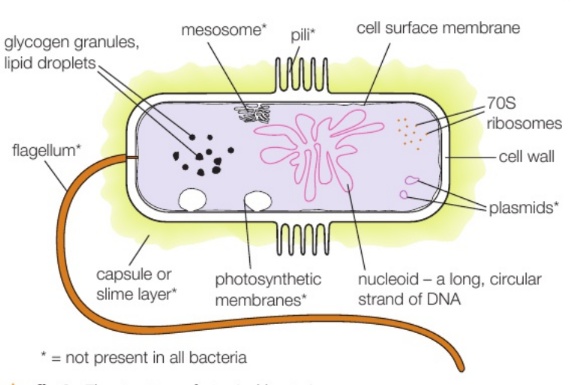bacteria and viruses- microbiology
1/11
There's no tags or description
Looks like no tags are added yet.
Name | Mastery | Learn | Test | Matching | Spaced |
|---|
No study sessions yet.
12 Terms
what are pathogens
microorganisms that cause disease

what do all bacteria have
a bacterial cell wall containing peptidoglycan
a cell surface membrane similar to those in eukaryotic cells
a nucleoid ( a single, circular stran of DNA that is the genetic material of the bacterium)
70S ribosomes which are the site of protein synthesis
what do some bacteria have
pili- thread-like projections from the surface of the cell wall
flagella- long rapidly rotating whip-like structures which can mvoe the bacteria about
a capsule or slime layer- a thick slippery substance around the outside of the cell wall
mesosomes- internal extensions of the membrane which fold into the cytoplasm and may be the site of cellular respiration
plasmids- small circles of additional DNA that code for specific characteristics
role of viruses
all act as pathogens
scientists use viruses to produce genetically modified organisms and they hope to use viruses to attack some of the bacteria that cause disease
what are viruses
viruses are the smallest of the microorganisms ranging from 0.02-0.3 micrometers
not cells- arrangement of genetic material and protein that invade living cells and take control of the cellular biochemistry to make more viruses
this reproduction and the fact that they change and evolve in an adaptive way means they are classed as living organisms
what are obligate intracellular parasites?
viruses classed as obligate intracellular parasites
can only exist and reporduce as aparasites only in the cells of other livign organisms
cause some kind of damage and disease as they take control of living cells to reproduce
they can resist drying and long periods of storage and still maintian their ability to infect cells
very few drugs have effect on viruses
what do all viruses have
All have:
a protein coat or capsid which consists of simple repeating protein units known as capsomers arranged in diff ways. The amount of genetic material needed to code for coat production is minimised by using these repeating units. These units also make assembling the protein coat in teh host cell as simple as possible
nucleic acids actign as genetic material- either DNA or RNA.
VAPS (viral attachment particles) which target proteins in the host cell surface membrane. Specific in tissue they attack and molecules they respond to and how viruses attach to cells they infect.
what do only some viruses have
a lipid envelope which is produced from the host cell membrane and which covers the genetic material and protein coat. The prescence of the envelope makes it easier for the viruses to pass from cell to cell, but makes them vulnerable to substances such as ether which will dissole the lipid membrane
how are viruses classified
classifies by their genome and their mode of replication
the form of genetic material influences how the virus makes new viruses in the host cell
what are DNA viruses
have DNA as their genetic material
the DNA acts directly as a template for both the viral DNA and for the mRNAs needed to induce synthesis of viral proteins. eg small pox, lamda phage
what are RNA viruses
have RNA as their genetic material
much more likely to mutate than DNA viruses
RNA viruses don’t produce DNA as part of their life cycle. Majority of RNA virus contian a single strand of RNA
eg plant and animal disease caused by RNA virus influde tobacco mosaic virus, ebola fever. polio, influenza and measles
what is retrovirus
a special type of RNA virus
they have protein capsid and a lipid envelope
the single strand of viral RNA controles the syntehsis of reverse transcriptase which is responsible for makign DNA molecules corresponding to teh viral genomes
This DNA is then incorporated into the host cell DNA and is used as a template for new viral proteins and ultimately a new viral RNA genome
HIV is retrovirus and some forms of leukemia also caused by retrovirus